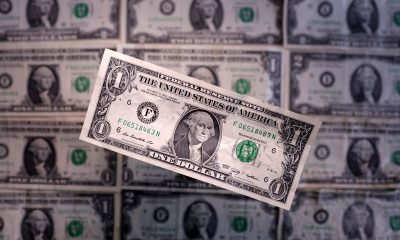Commodities
Gold clings to above $1,900 after softer June U.S. jobs report


© Reuters.
Investing.com — Gold isn’t about to lose its $1,900 handle yet — not with a U.S. labor market that finally may be cooling.
Futures of the yellow metal neared the mid-$1,900 point on Friday while the spot price of bullion was not too far away from that after a softer-than-expected U.S. jobs report for June suggested some tempering in the Fed’s hawkishness when the central bank’s policy-makers sit for their next rate review in three weeks.
The front-month on New York’s Comex settled at $1,932.50 an ounce, up $17.35, or 0.9%, on the day. For the week, the benchmark gold futures contract was virtually flat, gaining just over $3. Friday’s high of $1,940.90 for August gold compared with its three-month bottom last week at $1,900.60.
The , which reflects physical trades in bullion and is more closely followed than futures by some traders, was at $1,926.90. The intraday high of $1,926.90 contrasted with last week’s three-month low of $1,893.01.
“Gold came under pressure…but managed to hold above $1,900 and even recoup some of its losses,” said Craig Erlam, analyst at online trading platform OANDA.
Gold rallied after the Labor Department reported that U.S. employers added 209,000 in June, a number that came in below economists’ estimates for the first time in 16 months, signaling progress in the Federal Reserve’s bid to fight inflation with higher interest rates.
Wall Street’s economists had expected a jobs growth of 225,000 for last month, from a previously published 339,000 for May which the Labor Department revised down to 306,000 on Friday.
Fed seeks more evidence of inflation cooling; One jobs report alone won’t do it
The remained unchanged in June at 3.6% while wages expanded by 0.4% from a 0.3% growth in May. Fed officials have said employment and wage growth have to cool significantly to effectively restrain the worst inflation the United States has encountered in four decades.
Inflation, as measured by the Consumer Price Index, or , grew 4% year-on-year in May, slowing from a 40-year high of 9.1% in June 2022.
The Fed’s tolerance for inflation is, however, just 2% per annum. Since March 2022, the central bank has raised interest rates by 10 times, adding a total of 5% to the previous pandemic-era rate of 0.25%. While the its rate hike cycle last month, there is speculation it could resume that when it meets on July 26 for its next rates review.
To be sure, Chicago Fed President Austan Goolsbee told CNBC on Friday that one should “never make too much out of any one month of jobs numbers”.
“It is clear that the job market is still very strong but cooling,” he added. “I haven’t seen anything that says 1 or 2 more rate hikes this year is wrong.”
Commodities
Oil prices rise; U.S. crude inventories plunge, Russia-Ukraine truce eyed
Commodities
India’s Reliance to stop buying Venezuelan oil over US tariffs, sources say
Commodities
Oil prices climb on Venezuela supply worries

 Forex3 years ago
Forex3 years agoForex Today: the dollar is gaining strength amid gloomy sentiment at the start of the Fed’s week

 Forex3 years ago
Forex3 years agoUnbiased review of Pocket Option broker

 Forex3 years ago
Forex3 years agoDollar to pound sterling exchange rate today: Pound plummeted to its lowest since 1985

 Forex3 years ago
Forex3 years agoHow is the Australian dollar doing today?

 Cryptocurrency3 years ago
Cryptocurrency3 years agoWhat happened in the crypto market – current events today

 World3 years ago
World3 years agoWhy are modern video games an art form?

 Commodities3 years ago
Commodities3 years agoCopper continues to fall in price on expectations of lower demand in China

 Economy3 years ago
Economy3 years agoCrude oil tankers double in price due to EU anti-Russian sanctions



























